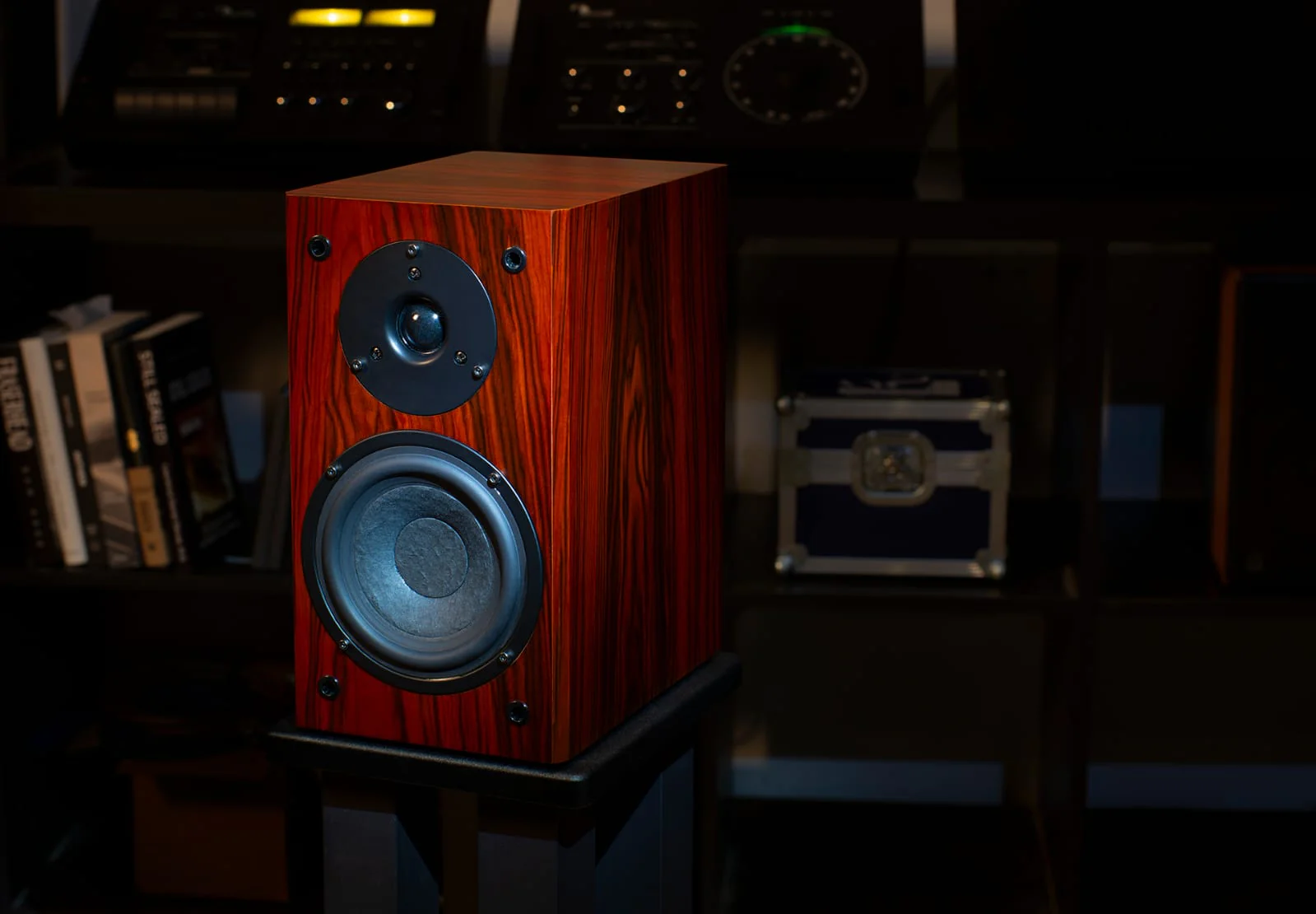Vera-Fi Audio LLC Vanguard Scout
A Better-Than-"Decent" Shoebox Loudspeaker for the Masses!
Dear Reader,
As I sit here polishing the final text of my review of this compact and insanely priced ($299/pr.) loudspeaker, I am listening to the Qobuz stream of Michael Franks’ breakthrough album, but not everyone has a Qobuz subscription so here it is on YouTube:
An audiophile friend introduced me to this album in the Spring of 1978. I had gone to his house to help him empty all the things from his refrigerator that had gone bad and rotted in the chaos following his young wife’s tragic death. That is not something you easily forget.
He had large Magneplanar loudspeakers and a nice turntable, and good taste in music. He kept the music playing, as I tried to put aright, the things that perhaps might have been capable of being put aright. Regardless my personal association with it, Sleeping Gypsy, in my opinion, belongs on the same shelf as Court and Spark and Aja, and I commend it to you.
I added these paragraphs just to say that, as I type away in the next room, the Vera-Fi Audio Scouts are doing a very creditable job of conveying the essentially sad, almost-would-be hipness of Michael Franks’ words and music. In short, the equipment was more than adequate for me to experience a genuine emotional reaction to, or connection with, the music. At the end of the day, I think that is the only metric that matters.
(Later on: I am listening to Norwegian pianist and composer Tord Gustavsen’s ECM album What Was Said, the title track of which is a re-do of Bach’s “O Sacred Head Surrounded” chorale. You also absolutely must hear it!!! Again, here's the YouTube video:
And, as long as I am at it: Susan Wong’s "The Winner Takes It All"
and Kate St. John’s “There Is Sweet Music Here That Softer Falls"
Don’t miss them!
Well done, all. And now, here is how I had planned to start this review:
The first issue of Stereo Review magazine I ever read was dated September, 1968. It was in my dentist’s waiting room. That issue was memorable for Julian Hirsch’s rave review of Bose’s standmounted Model 901 loudspeaker. I was already reading Popular Electronics, but Stereo Review’s coverage of so many different music genres fascinated me, so I subscribed.
Years later (1994), I asked Julian Hirsch for his autograph, at a lunchtime live-music event I produced at the last-ever Chicago Summer CES; he was flattered. That event was memorable (in the first instance) because Michael Fremer was an invitee. While waiting for the dining-room door to be unlocked, Michael wondered aloud whether Julian Hirsch would be in attendance. Michael then launched into an ad-lib impersonation… of Julian Hirsch. Not realizing that Mr. Hirsch was standing right behind him. My recollection is that Mr. Hirsch took it in good grace.
That event was the audio-press-lunch launch of Museatex’s Melior One large planar loudspeaker. A rather unique design, the Melior One’s panel was driven by one centrally-located voice-coil-and-magnet system. The Melior One also had an elaborate rear acoustical screen, to contour the loudspeaker’s bipolar frequency response.
To make the event itself very memorable, Museatex enlisted me to produce a monophonic studio recording of Arturo Delmoni, playing one solo-violin part of the slow movement of J.S. Bach’s Concerto in D-minor for Two Violins. That recording was played back over a stereo pair of the Melior One planar loudspeakers, while Arturo stood between them playing the other solo-violin part live from memory. Darn impressive!
After the applause died down, I asked if there were any questions. The only question from that august audience was, someone wanted to know what kind of microphone I had chosen. I smiled and replied “RCA BX-44,” which was a pre-WWII broadcast-industry ribbon microphone. That caused a bit of a stir. Or, at least, some murmurs. So I told everyone that I would be glad to explain at length, but in private conversations.
However, nobody seemed to want to follow up on that particular audio-show trivia bit. Had anyone wished to, I would have said that, for playback in a large restaurant space (the Everest Room, in fact), I wanted a lot of detail, but without harshness. So I went for a slightly “Euphonic” mic choice, one which would allow me to set up the single microphone rather close-in.
In retrospect, there was also probably an aspect of, “People are going to ‘listen with their eyes’ anyway; and, they will be watching Arturo. Therefore, the pre-recorded part will just ‘be there,’ regardless of anything else.”
Even though Julian Hirsch had a reputation as the ultimate “Sergeant Joe Friday” (Objectivist) Audio-Equipment Reviewer of the 1960s and 1970s, his bywords being “Just the facts, Ma’am;” in his Bose 901 review, Hirsch wrote, “I have never heard a speaker system in my own home [that] could surpass, or even equal, the Bose 901 for overall realism of sound.” Hirsch concluded that the 901 ranked “with a handful of the finest home speaker systems of all time.” (A pity that Mr. Hirsch did not rattle off that list, then and there, for posterity.)
I actually visited a local TV (and other home-electronics) store to hear the 901s, which were set up in a rather large room. They were placed atop the chrome-plated version of their Mid-Century-Modern “Tulip” loudspeaker stands. They were very impressive.
Years later, loudspeaker importer and Impresario (IMHO; and, IMHO not to be confused with “designer”) Irving M. Fried would go to great pains to inform me that I had been impressed by Bose 901s only because I did not “know how to listen.” Fried claimed that when the Bose 901 was first shown to the elite of Japan’s audio press, after a few tracks, they asked to hear a female pop vocal.
Upon hearing a bit of one female pop-vocal track, the scribes all (supposedly) stood up, and started to leave. When asked why, supposedly the Bests and Brightests of Japanese High-End Audio Ink-Stained Wretchedness replied, “Barbra Streisand’s mouth is not eleven feet wide.”
Ah so.
In the early 1970s, when my oldest brother moved out, and took his fold-down “Suitcase Stereo” with him, my mother browsed in the Lafayette Radio Electronics catalog I had left lying around. My mother plashed out (IIRC) $159 for a package-deal component stereo system, if you can believe that. Two large ported 2-way bookshelf loudspeakers; a Lafayette solid-state 30Wpc integrated amp; and a Garrard plastic-era turntable with Shure cartridge. For whatever reason, my mother loved Creedence Clearwater Revival; and she loved that stereo.
It was when I was living in Nashville (in the late 1970s) that I first became aware of The Abso!ute Sound, and the phenomenon of high-end audio. I first heard some version of the LS3/5A “Shoebox” BBC Monitor at Nicholson’s, which was both a record store and audio salon in Nashville’s West End. They were Chartwell LS3/5As, in fact. The LP that was playing was the famous RCA Maurice André Baroque trumpet-concerto recording of music of Pachelbel and Fasch. I was amazed.
The resolving power, frequency extension, and dynamics of the Chartwell LS3/5As’ presentation of the trumpet’s recorded sound was something I had never heard before. (BTW, there’s an allegedly “NM” LP of that up on eBay now, for the princely sum of $22; and six others under $20. Jump on it!)
Note, one of my younger brothers was a trumpet student who eventually graduated from the Boston Conservatory. So I long have had mental memory banks full of the sound of a live trumpet. At the time, I had already invested in Fried Products Company Q2 loudspeakers, which were “line-tunnel-ported” 2-ways, with 8-inch woofers.
Later, on, when it was time to upgrade… I loved the LS3/5A. But, I recognized that its bass limitations made it not the loudspeaker for me. Therefore, in an effort to stay within the BBC “family,” I bought Spendor SP1s.
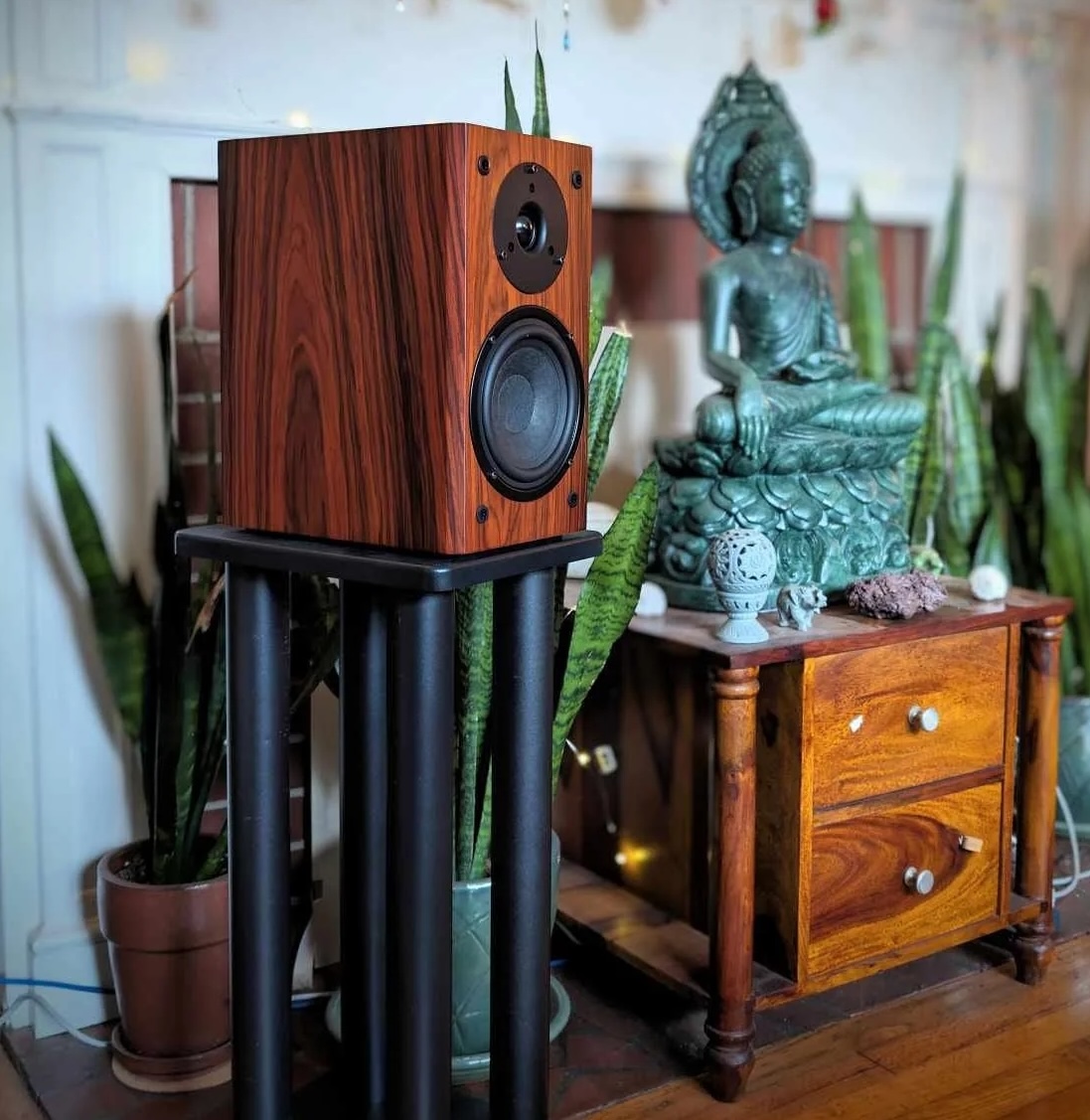
Anyway, Vera-Fi Audio’s “Vanguard Scout” shoebox-sized (but, which is DEFINITELY NOT an LS3/5A DESCENDANT OR EMULATION) loudspeaker, direct-to-consumer priced at $299 the pair, has had me ruminating on quite a few things.
Starting with, the way hi-fi costs have outpaced inflation since 1970. Yes, there are more bells and whistles today, but… I can remember when $19,000 was an insanely large amount of money for a pair of loudspeakers (those being Duntech’s Sovereign 2001s, in the early 1980s). Today, nobody blinks at loudspeakers costing $325,000 the pair. If one were to back-date today’s $299/pr. price for the Scouts back to 1980, in 1980, the Scouts would have cost $72.32 the pair.
Next, I can only imagine what Julian Hirsch would have written about the Vera-Fi Audio Vanguard Scout.
Finally, “For the Love of God, Montresor!,” how the Heck can they sell a shoebox loudspeaker with a genuine Rosewood-veneer cabinet for $299 the pair????
Let’s start with what Julian Hirsch might have thought about the Vera-Fi Audio “Scout.” The Quick-and-Lazy Answer is:
"Of all the loudspeakers that I have ever heard,
these are most definitely two of them!"
I seem to recall that that quip originated with Michael Fremer, but maybe it was just “in the air” back then. The perception back then being, at times, Mr. Hirsch would appear to be straining to say something, anything that was not negative.
The Scout is the entry-level loudspeaker offering from the related-by-common-ownership companies Vera-Fi Audio and XSA Labs. Both companies are partnerships, with the principals being Mark Schifter (formerly of Audio Alchemy), and Dr. Viet Nguyen, who is an aerospace scientist. The Scout is assembled in the United States, but the major components come from China. And you, in your Best Claude Rains Voice, are shocked, truly shocked.
The Scout’s cabinet is veneered in rosewood, with a flawless satin finish. The front panel has grommet attachments for a fabric grille. (I removed the grilles for my listening.) The cabinet is 12 x 6.75 x 9.5 inches (H x W x D).
Although the Scout has the same form factor as the various generations and incarnations of the “British Broadcasting Corporation Shoebox Monitor,” crucially, it is a ported design, rather than a sealed box. That said, with a 5.25-inch fiber-cone woofer and a 25mm soft-dome tweeter, the Scout has a driver compliment that is a very familiar combination.
Vera-Fi claims for the Scout a -6dB point of 60Hz, which I found to be credible. In that context, please keep in mind that a long time ago, John Atkinson estimated the box tuning of the LS3/5A’s sealed cabinet to be 93Hz.
So, I think that particular data point makes it rather obvious why the Scout is a ported design. Now, 93Hz is still definitely in the Bass range. But a loudspeaker with a box tuning of 93Hz is definitely going to sound light in the bass, especially compared to a larger ported loudspeaker with a 6.5-inch woofer. Which is a very well-populated product niche.
Most of the ported 6.5-inch 2-ways I have seen have had box tunings around 41Hz. That makes perfect sense, because 41Hz is the frequency of the lowest open string on a four-string electric bass guitar. Therefore, except for synth-bass tracks, 41Hz is the “foundation” of most rock and pop music. In this context, it is important to note that going up from 5.25 inches to 6.5 inches in woofer-cone diameter is a change in diameter of only circa 24%; however, the increase in frontal area is 53%: 21.62 square inches vs. 33.18 square inches. (πr2)
SIDEBAR: As far as I am concerned, frequency numbers can be deceptive or confusing, even despite one’s intellectual knowledge that musical frequencies are logarithmic in nature. The consequence of that is, a difference of 10Hz is not a big deal at the far-right end of a piano keyboard (the highest notes, with frequencies over 3,000Hz). But 10Hz is a big difference down at the far-left end of a piano keyboard (the lowest notes, with frequencies under 40Hz). So therefore, in thinking about frequency bands, I always try to use real musical instruments as the Sanity Check.
Here's a Thought Experiment. Imagine a violin. Imagine a competent violinist playing the famous Concertmaster Solo from Rimsky-Korsakov’s Scheherazade. A lot of that solo is played on the violin’s top string, the E string.
OK, what is the frequency of the violin’s top open string?
(People usually guess way too high.)
How about 660Hz? So, the opening note of the Scheherazade Concertmaster Solo (as well as the top note of the opening passage of Mendelssohn’s Violin Concerto) is E = 1,320Hz. That’s not a huge number, but that played note sounds very high. I’ll end this excursion by saying that Middle C on a piano is 262Hz. So, therefore, I regard the Bass band as extending up to 100 or at most 120Hz, but no higher.
Back to the Scout
I do know a fair amount about the inner workings of the loudspeaker business, from the consulting and design/build work I have carried on for the past four years or so. I can say this: if it were really easy, everybody would be in the loudspeaker business. But it’s not easy. Offshoring manufacturing is the way to drive down prices, but the lines of communication have to be very clear, and the single most important thing is to find competent and honest trading partners.
The keys to low pricing are first, engineering out any needless complexities, and second, having the capital resources to bring to bear economies of scale. You get quoted one price for a run of 12 pairs of loudspeaker cabinets, and a very different price for a run of 200 pairs of loudspeaker cabinets.
So, to answer the question “How do they do that?,” I think that the three-word answer is “The Laffer Curve.” * As in, the remarkably low retail pricing is what creates the demand, which in turn enables major economies of scale.
Looking at Vera-Fi Audio’s product page for the Scout it’s very apparent that the team knows what they are about. I am very impressed that designer Viet Nguyen has the courage of his convictions, in that he admits (or confesses to) having designed a loudspeaker with a “Personality”:
The balance and voicing of the Vanguard Scout
is optimized for non-fatiguing listening pleasure
with all genres of music.
Elsewhere, Dr. Nguyen notes that that woofer was chosen for its warm midrange that (my words not his) flatters well-recorded vocals.
My colleague Chris Huston, the musician (his band was The Undertakers), recording engineer (The Young Rascals’ “Groovin’”), and producer (The World Is a Ghetto), once told me that “A loudspeaker without a personality is like a song without a ‘hook.’” And, for the most part, I think that that is good advice. Especially at the lower end of the price ladder, I think it is better to go for a non-fatiguing sound that flatters the music, than go for a “flat frequency response” that might end up sounding clinical.
I also found it interesting that the Scout’s crossover uses asymmetrical slopes (Dick Shahinian also did that), and that the crossover design, while minimalist (2 each of resistors, capacitors, and coils), does allow for both drivers to be connected in positive polarity. These days, the frequent use of even-order crossovers (such as Second-Order Linkwitz-Riley) results in a phase rotation that requires the tweeter to be connected in reverse polarity. The Scout’s crossover frequency is 1700Hz, which indicates that the tweeter is admirably wideband.
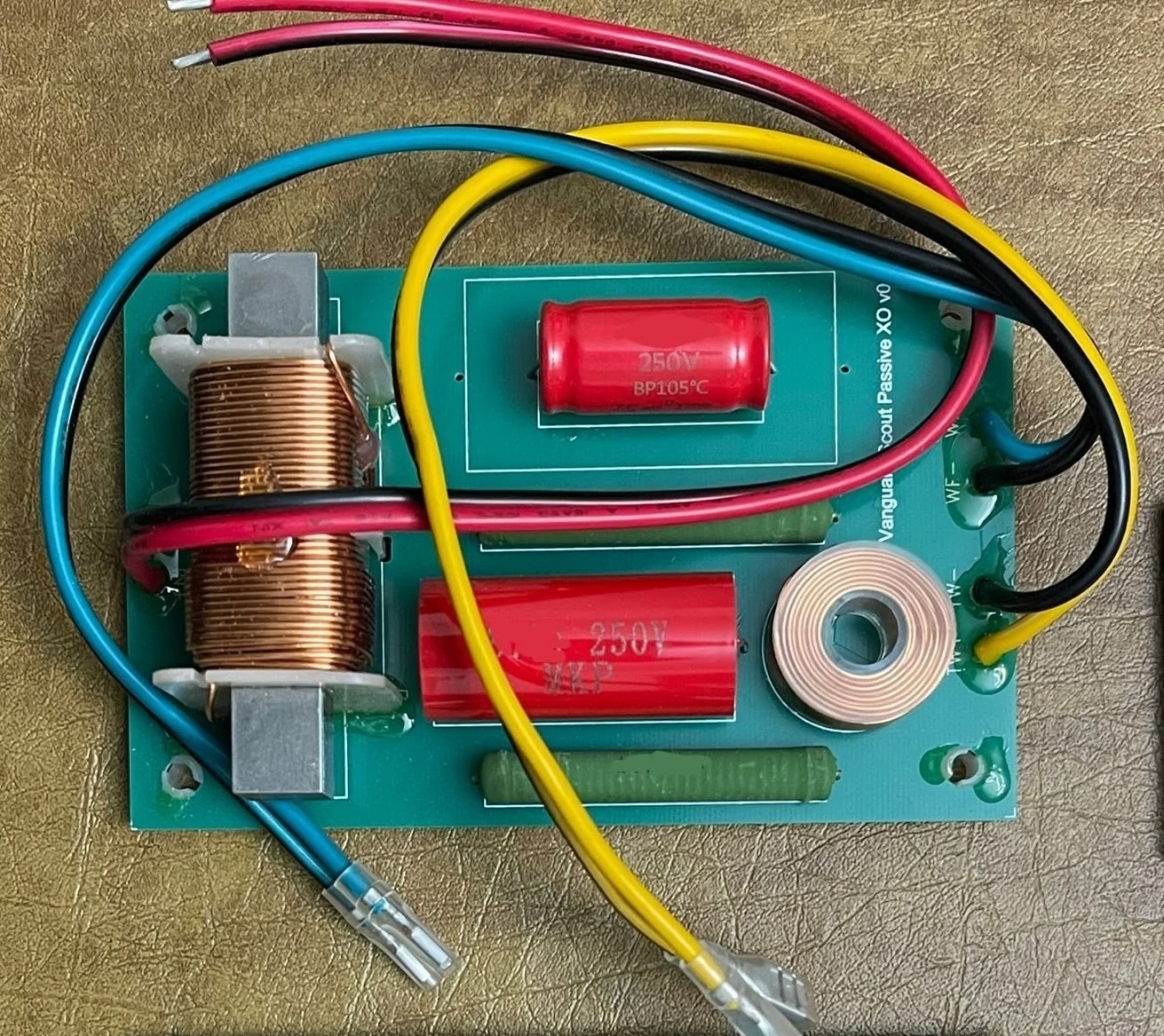
The other relevant numbers are, 8 Ohms nominal Impedance, 50 watts Power Handling, and 84.5dB Efficiency. I powered the Scouts with a Parasound Zamp3 linear analog power amplifier, fed by a Grace Design m900 DAC/HPA/Preamp. I used Audioquest RCA interconnects, and WireWorld loudspeaker cables. All of which was intended to be similar to the equipment most people will be connecting to loudspeakers in the $300/pair price tier. So, no Bricasti, and no darTZeel. Alas.
Listening
The Scouts arrived well-packed in one sturdy carton with custom foam dividers. I removed the grilles and then set the loudspeakers up and had a quick listen. Not very impressive—they sounded what I call “Green.” Maybe even a little bit plastic-y. A Golden Ears friend who happened to be here to listen to my latest prototype, and who briefly listened to the Scouts, offered the opinion that they sounded like affordable loudspeakers.
I was not surprised. So, as shown in the photo below, I realigned the loudspeakers to face each other, and I connected one loudspeaker in Reverse Polarity (Red to Black). I then fed them a diet of loud Augmented Pink Noise for about 72 hours. My Augmented Pink Noise starts with John Atkinson’s Pink Noise from Stereophile’s Editor’s Choice CD. I then boost the 5kHz band by 2dB, the 10kHz band by 4dB, and the 20kHz band by 6dB. Do the same at your own risk!
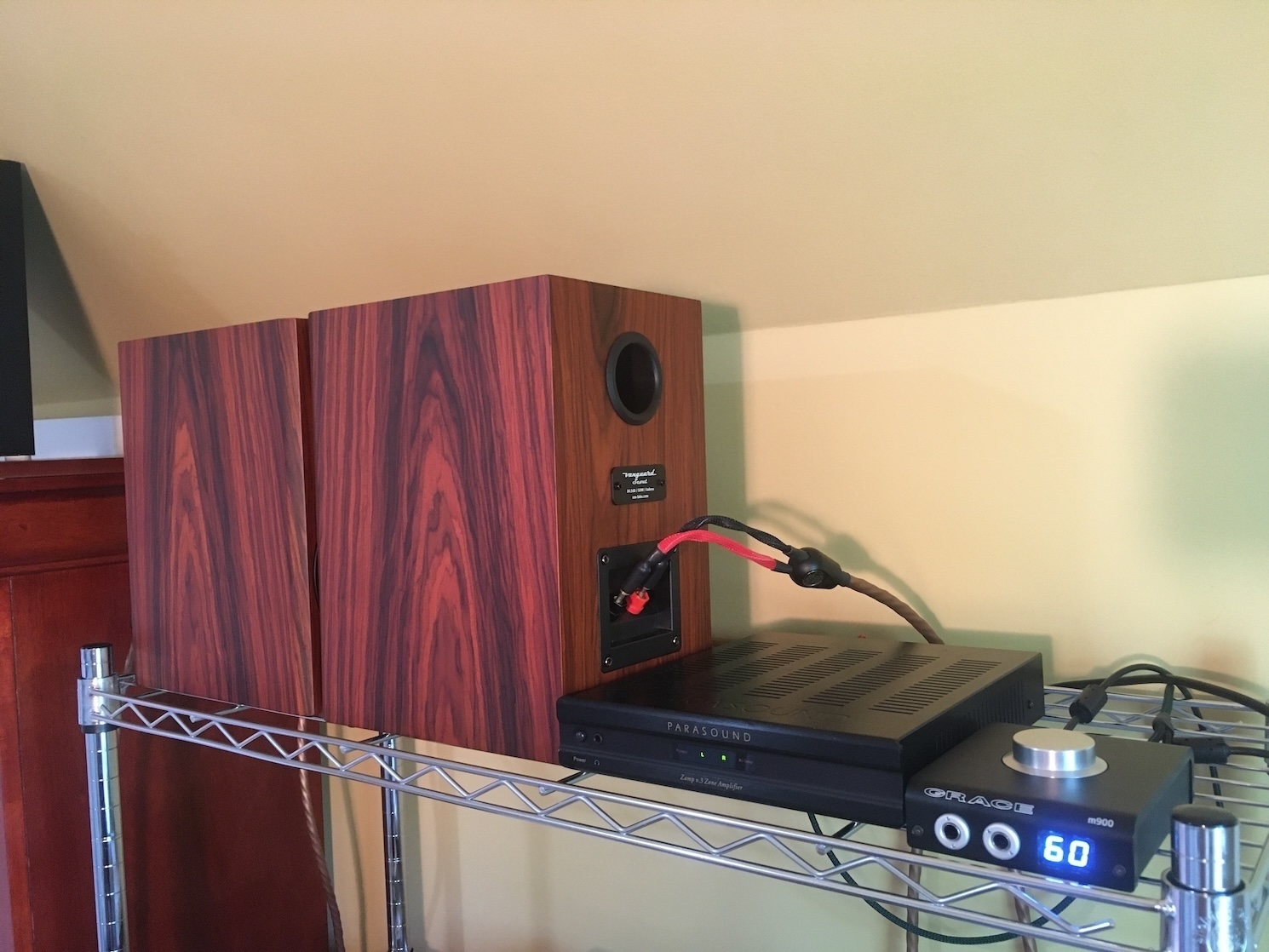 JM's Burn-In Process
JM's Burn-In Process
I think that it is fair to say that the burn-in period transformed the sound of the Scouts. The high frequencies were better integrated and smoother. The bass opened up a bit. The midrange was very listenable, and with great detail.
One test track was Peggy Lee’s percussion-heavy single “Fever,” from 1958. It’s Peggy, singing her own version of the song, with additional material that alludes to and quotes Shakespeare, accompanied only by bass and percussion. The percussion hits (I don’t know whether the big drum was a tympani or a bass drum) were surprisingly powerful.
That said, I also thought that, compared to a larger speaker with a larger woofer, that I was hearing a little more of a contribution from the port than I liked. Longtime readers of mine will recall that for a very long time, Ella Fitzgerald’s “Easy to Love” from her Cole Porter Songbooks has been one of the test tracks I use for almost all reviews.
A markedly different track that I have also been using for quite some time as a ying/yang complement to Ella’s “Easy to Love” is Gordon Lightfoot’s pre-celebrity ballad “Affair on 8th Avenue” I urge you to check it out.
What I listen for is Lightfoot’s “Characteristic Adult-Male Chest Resonance,” which usually is found between 80Hz and 120Hz. Just think of the soothing voice of a late-night male Classical disc jockey. And, yes, I thought I heard a little extra emphasis in Lightfoot’s chest resonance. So I began considering Field Modifications to the Scouts. (Obviously, there was no need for the famous “Charmin Mod.”)
It turns out that Vera-Fi’s Mark Schifter has no problem with customers’ experimenting with Port Stuffing. That is, filling the port with absorptive material, to make the loudspeaker behave more like a sealed box. OK!
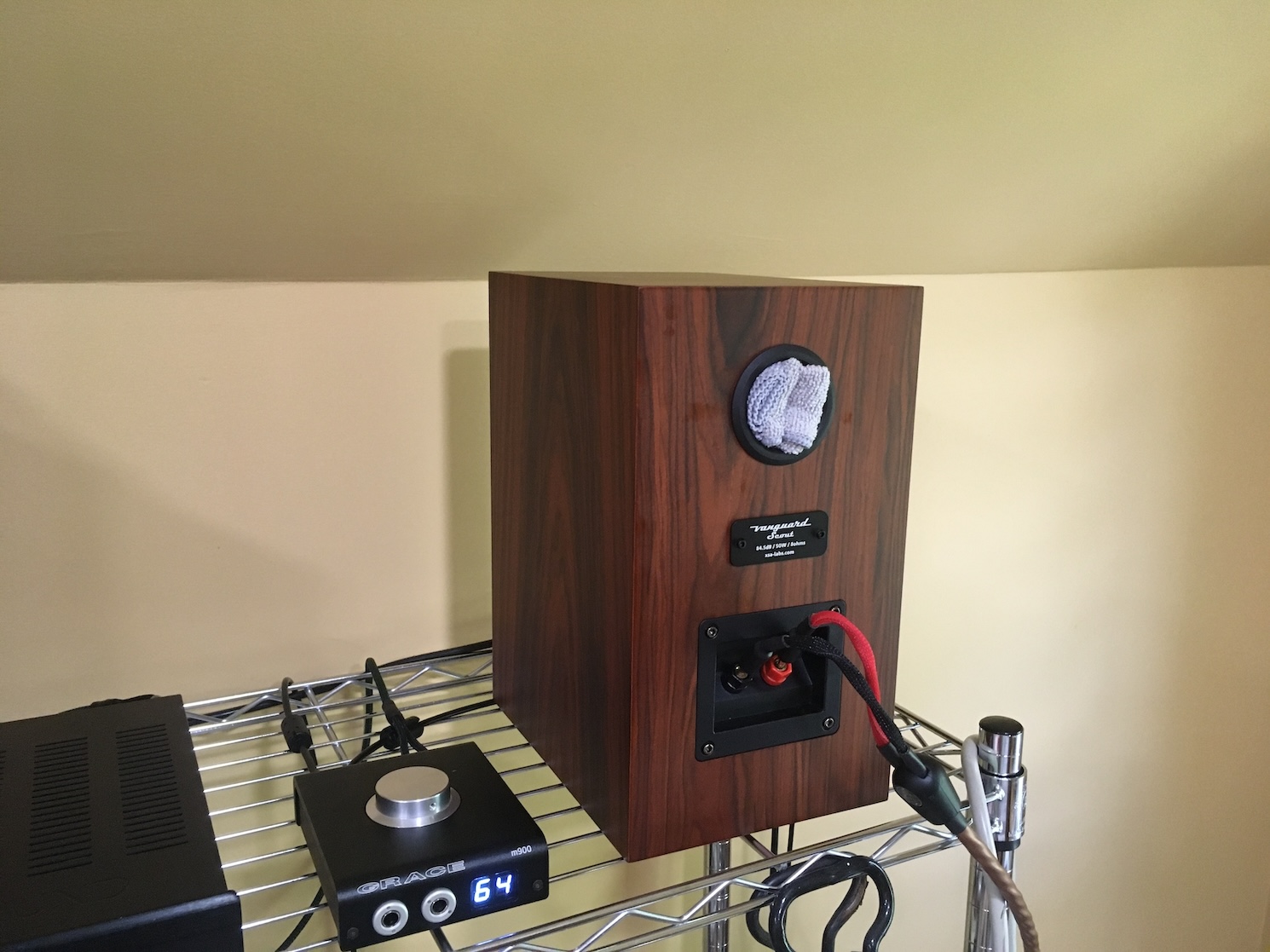
I just happened to have a new package of Rubbermaid “Multi-Purpose Microfiber Cloths” on hand. I rolled two of them up individually, and then overlapped the two ends at the rolls’ thirds divisions, and they fit perfectly into the ports. I really liked the effect. But I was afraid that it might have been slightly an overkill.
I then, in honor of the original ProAc Tablette, replaced the microfiber cloths with two handfuls of circa five-inch long Cocktail Sipper Straws I obtained from Amazon. The package cost $7, and it had more than enough straws to stuff both ports.
In my mind at least, what the straws do is to increase friction and slow the airflow down a bit. But most of the benefit comes from making the airflow less chaotic and more “laminar.” I was happy with the result.
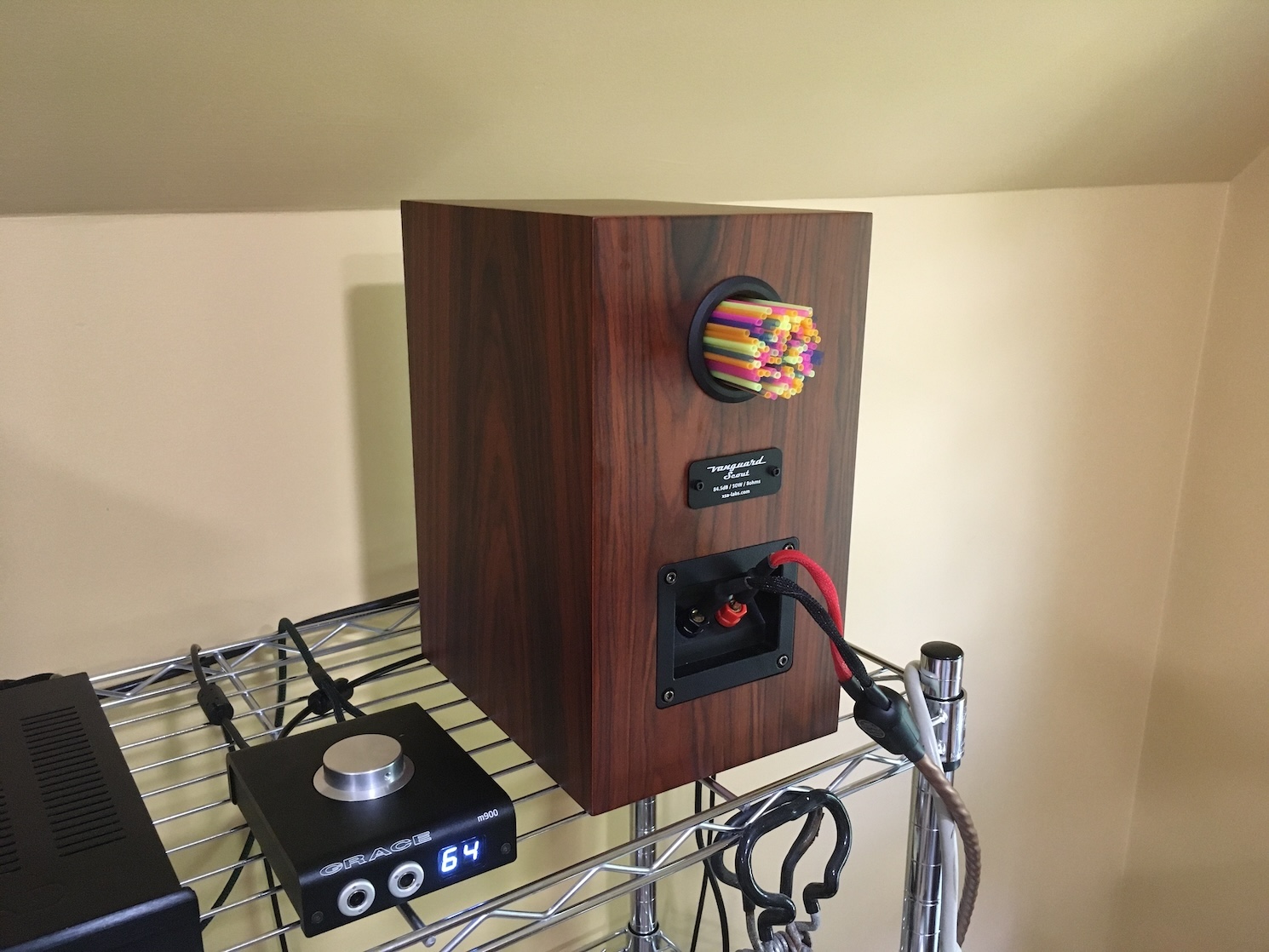
Neither of these proposed modifications are bank-breakers, obviously. If you don’t like the results, you can put the microfiber cloths back among your cleaning supplies, and perhaps a young person you know can make an Eiffel Tower model out of the straws.
Summing Up
What we have here is a remarkably affordable and competent loudspeaker that looks much better than nearly all of its same-price-tier competition. Therefore, why should anyone ever spend any more than $299 for a pair of loudspeakers?
Well, sometimes, if you spend more, you get more. My guess is that, in the likely quantities, the soft-dome tweeter used in the Scout can be had for circa $5 each (of course, not including Customs, Insurance, and Freight). But it’s also possible to spend more than $300 each for tweeters, or even more.
It just so happens that my current prototype uses an Air Motion Transformer tweeter (the TPL-75) from the Spanish company Beyma, and my cost is over $300 each. The Beyma TPL-75 is a truly remarkable tweeter. (Starting with, the manufacturer claims usable output down to 1kHz.) And if money is really no object, the top-of-the-line Beryllium tweeter from ScanSpeak will run you close to $650 each.
Once again, I want to recommend a largely unknown female vocal from 2002 that continues to captivate me: Lisa Richard, a former Broadway singer and performer who sang in 1,400 performances of Mama Mia, singing “Never Have I.” That’s a song that Jane Olivor commissioned from Kathy Wakefield and Stephen Schwartz, but which unaccountably, she never recorded herself.
I heard Jane sing it live in 1982, and it hugely impressed me. Literally decades later, I found Lisa Richard’s CD Virgin Tracks, by which she meant, a compilation of never-before recorded songs. The entire album is up on Qobuz, and from time to time, used CDs show up in the marketplaces. You can listen to the album on YouTube
The production and arrangements of Virgin Tracks are somewhat of the 1990s “Everything, Including the Kitchen Sink” school, but I listen past that. “Never Have I” is basically a story song about having been the girlfriend to a succession of guys who were more passionate about and interested in their hobbies and outside interests, than they were passionate about or interested in their always-taken-for-granted girlfriend.
In the first verse of “Never Have I,” there is a classical guitar (or at least, it sounds like one to me) playing in the accompaniment. On the Beyma TPL-75, the guitar sound is very rich in shimmering, interacting harmonic overtones. That is why people spend the money to buy loudspeakers with tweeters that cost more than $300 each. On the Scouts, the guitar’s fundamentals are there, but the complexities of the harmonics were nowhere near as well-rendered.
Anyway, Vera-Fi Audio and XSA Labs have already answered the question why anyone would spend more than $299/pr. for loudspeakers: The XSA Labs Vanguard is, according to XSA, “a modern and sexier interpretation of the classic British bookshelf monitor in satin finished bamboo,” at the $995/pr. price point. And, when we are talking about the XSA Vanguard, it really is a “BBC Shoebox Heritage” loudspeaker, in that it is a sealed-box design.
I should also mention that Vera-Fi Audio’s product lines include Wi-Fi amplifier packs that you can Velcro to the back of your loudspeakers (and, they do offer a package deal if you buy at the same time as Scouts). Vera-Fi also has active subwoofers, 10-inch for $199/ea., and 12-inch for $399/ea. Vera-Fi also has occasional discounts, and also from time to time, they have “B-Stock” pairs for sale.
So, color me impressed. The one thing I had wanted to do with the Scouts, but which I did not have the time or bandwidth for, was to borrow a second pair, and then position them in the old “Stacked Advents” array, where the loudspeakers are stacked vertically, but with the upper one upside-down, to effectuate a demi-derrière’d D’Appolito (or MTM) implementation.
Interestingly enough, Mark Schifter told me that it had already been tried, and that it works very well. And of course, Vera-Fi has a money-back guarantee.
Tracking Angle is trying to be a-political but will make an exception for this reference to the "laughable curve"_ed.
Specifications
Vanguard Scout: 12 x 6.75 x 9.5 inches (H x W x D).
Circa 12 pounds each
8 Ohms nominal Impedance
50 watts Power Handling
84.5dB Efficiency


